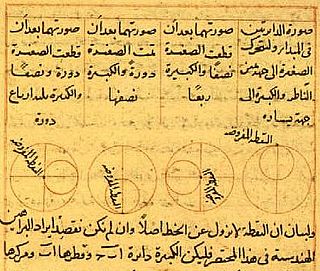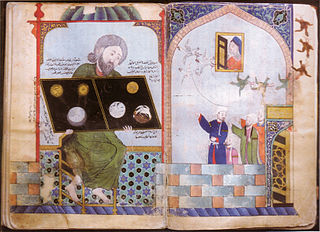Smallpox vs. measles
Al-Razi wrote:
Smallpox appears when blood "boils" and is infected, resulting in vapours being expelled. Thus juvenile blood (which looks like wet extracts appearing on the skin) is being transformed into richer blood, having the color of mature wine. At this stage, smallpox shows up essentially as "bubbles found in wine" (as blisters)... this disease can also occur at other times (meaning: not only during childhood). The best thing to do during this first stage is to keep away from it, otherwise this disease might turn into an epidemic.
This diagnosis is acknowledged by the Encyclopædia Britannica (1911), which states: "The most trustworthy statements as to the early existence of the disease are found in an account by the 9th-century Persian physician Rhazes, by whom its symptoms were clearly described, its pathology explained by a humoral or fermentation theory, and directions given for its treatment." [33]
Al-Razi's book al-Judari wa al-Hasbah (On Smallpox and Measles) was the first book describing smallpox and measles as distinct diseases. [34] It was translated more than a dozen times into Latin and other European languages. Its lack of dogmatism and its Hippocratic reliance on clinical observation show al-Razi's medical methods. For example, he wrote:
The eruption of smallpox is preceded by a continued fever, pain in the back, itching in the nose and nightmares during sleep. These are the more acute symptoms of its approach together with a noticeable pain in the back accompanied by fever and an itching felt by the patient all over his body. A swelling of the face appears, which comes and goes, and one notices an overall inflammatory color noticeable as a strong redness on both cheeks and around both eyes. One experiences a heaviness of the whole body and great restlessness, which expresses itself as a lot of stretching and yawning. There is a pain in the throat and chest and one finds it difficult to breathe and cough. Additional symptoms are: dryness of breath, thick spittle, hoarseness of the voice, pain and heaviness of the head, restlessness, nausea and anxiety. (Note the difference: restlessness, nausea and anxiety occur more frequently with "measles" than with smallpox. At the other hand, pain in the back is more apparent with smallpox than with measles). Altogether one experiences heat over the whole body, one has an inflamed colon and one shows an overall shining redness, with a very pronounced redness of the gums. (Rhazes, Encyclopaedia of Medicine)
Books and articles on medicine
- Al-Kitab al Hawi
This 23-volume set medical textbooks contains the foundation of gynaecology, obstetrics and ophthalmic surgery [32]
- The Virtuous Life (al-Hawiالحاوي).
This monumental medical encyclopedia in nine volumes—known in Europe also as The Large Comprehensive or Continens Liber (جامع الكبير) ——contains considerations and criticism on the Greek philosophers Aristotle and Plato, and expresses innovative views on many subjects. [38] [39] [40] Because of this book alone, many scholars consider al-Razi the greatest medical doctor of the Middle Ages.
The al-Hawi is not a formal medical encyclopedia, but a posthumous compilation of al-Razi's working notebooks, which included knowledge gathered from other books as well as original observations on diseases and therapies, based on his own clinical experience. It is significant since it contains a celebrated monograph on smallpox, the earliest one known. It was translated into Latin in 1279 by Faraj ben Salim, a physician of Sicilian-Jewish origin employed by Charles of Anjou, and after which it had a considerable influence in Europe.
The al-Hawi also criticized the views of Galen, after al-Razi had observed many clinical cases which did not follow Galen's descriptions of fevers. For example, he stated that Galen's descriptions of urinary ailments were inaccurate as he had only seen three cases, while al-Razi had studied hundreds of such cases in hospitals of Baghdad and Rey. [41]
- For One Who Has No Physician to Attend Him (Man la Yahduruhu Al-Tabib) (من لا يحضره الطبيب)—A medical adviser for the general public
Al-Razi was possibly the first Persian doctor to deliberately write a home medical manual (remedial) directed at the general public. He dedicated it to the poor, the traveller, and the ordinary citizen who could consult it for treatment of common ailments when a doctor was not available. This book is of special interest to the history of pharmacy since similar books were very popular until the 20th century. Al-Razi described in its 36 chapters, diets and drug components that can be found in either an apothecary, a market place, in well-equipped kitchens, or and in military camps. Thus, every intelligent person could follow its instructions and prepare the proper recipes with good results.
Some of the illnesses treated were headaches, colds, coughing, melancholy and diseases of the eye, ear, and stomach. For example, he prescribed for a feverish headache: " 2 parts of duhn (oily extract) of rose, to be mixed with 1 part of vinegar, in which a piece of linen cloth is dipped and compressed on the forehead". He recommended as a laxative, " 7 drams of dried violet flowers with 20 pears, macerated and well mixed, then strained. Add to this filtrate, 20 drams of sugar for a drink. In cases of melancholy, he invariably recommended prescriptions, which included either poppies or its juice (opium), Cuscuta epithymum (clover dodder) or both. For an eye-remedy, he advised myrrh, saffron, and frankincense, 2 drams each, to be mixed with 1 dram of yellow arsenic formed into tablets. Each tablet was to be dissolved in a sufficient quantity of coriander water and used as eye drops.
- Doubts about Galen (al-Shukūk ʿalā Jalīnūs)
In his book Doubts about Galen, [42] al-Razi rejects several claims made by the Greek physician, as far as the alleged superiority of the Greek language and many of his cosmological and medical views. He links medicine with philosophy, and states that sound practice demands independent thinking. He reports that Galen's descriptions do not agree with his own clinical observations regarding the run of a fever. And in some cases he finds that his clinical experience exceeds Galen's.
He criticized Galen's theory that the body possessed four separate "humors" (liquid substances), whose balance are the key to health and a natural body-temperature. A sure way to upset such a system was to insert a liquid with a different temperature into the body resulting in an increase or decrease of bodily heat, which resembled the temperature of that particular fluid. Al-Razi noted that a warm drink would heat up the body to a degree much higher than its own natural temperature. Thus the drink would trigger a response from the body, rather than transferring only its own warmth or coldness to it. (Cf. I. E. Goodman)
This line of criticism essentially had the potential to completely refute Galen's theory of humors, as well as Aristotle's theory of the four elements, on which it was grounded. Al-Razi's own alchemical experiments suggested other qualities of matter, such as "oiliness" and "sulphurousness", or inflammability and salinity, which were not readily explained by the traditional fire, water, earth, and air division of elements.
Al-Razi's challenge to the current fundamentals of medical theory was quite controversial. Many accused him of ignorance and arrogance, even though he repeatedly expressed his praise and gratitude to Galen for his contributions and labours, saying:
I prayed to God to direct and lead me to the truth in writing this book. It grieves me to oppose and criticize the man Galen from whose sea of knowledge I have drawn much. Indeed, he is the Master and I am the disciple. Although this reverence and appreciation will and should not prevent me from doubting, as I did, what is erroneous in his theories. I imagine and feel deeply in my heart that Galen has chosen me to undertake this task, and if he were alive, he would have congratulated me on what I am doing. I say this because Galen's aim was to seek and find the truth and bring light out of darkness. I wish indeed he were alive to read what I have published. [43]
- Crystallization of ancient knowledge, and the refusal to accept the fact that new data and ideas indicate that present day knowledge ultimately might surpass that of previous generations.
Al-Razi believed that contemporary scientists and scholars are by far better equipped, more knowledgeable, and more competent than the ancient ones, due to the accumulated knowledge at their disposal. Al-Razi's attempt to overthrow blind acceptance of the unchallenged authority of ancient sages encouraged and stimulated research and advances in the arts, technology, and sciences.
- The Diseases of Children
Al-Razi's The Diseases of Children was the first monograph to deal with paediatrics as an independent field of medicine. [11] [12]
- Mental health
As many other theorists in his time of exploration of illnesses, he believed that mental illnesses were caused by demons. Demons were believed to enter the body and possess the body.



















